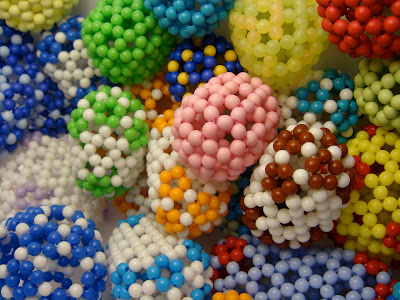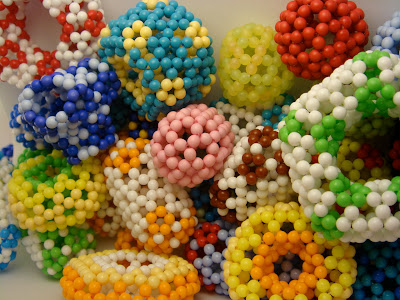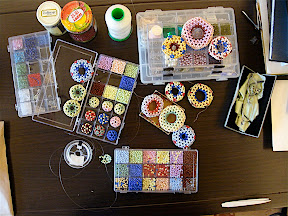I gave a talk in the ACS meeting this summer. Here is the pdf file for the talk in the acs site:
Classification and Construction of Topologically Nontrivial Graphitic Materials
Showing posts with label general. Show all posts
Showing posts with label general. Show all posts
Friday, November 6, 2009
Tuesday, October 27, 2009
Comment on the size of beads
Chuang and I have tried many different sizes of beads in the construction of beaded structures. From the local of stores in the Taipei area, we can find beads with sizes ranging from 3mm to 20mm. At the beginning, I made a lot of C60, T120, T240, and other toroidal carbon nanotubes with 4mm beads. These beads are quite small and the size of hole is even smaller. It is not easy to do weaving. The resulting structures are small too and look cheap to me. Since the effort to make a beaded molecule is basically quite independent of sizes, at least for beads ranging from 4mm up to 8mm, we decided to do at least with 6mm beads after about a year of playing with 4mm beads. So now most of our large beaded models were made with 6mm beads.
Here is one of early C60 made of 25mm transparent plastic beads (looks like crystal). To make the structure stable, we have to use very thick fishing line. To make a beaded model with beads of this size is quite different from those models with smaller beads (less than 10mm). The friction between the beads and fishing line seem to be too small to hold the structure together. The gravitation of beads become important at this size. So the final structure does not look like being holding by the string only.
Chuang had also made a T120 using the same size of beads. This model is big. Chuang used it as a pillow when he stayed in the lab late at night without going back to his apartment. Unfortunately, the structure is in fact not that robust and it breaked up in a few days before we had a chance to take a picture.
If we want to make structures with even larger beads, it is hard to find commercial beads. We came up with the idea of using Ping-Pong balls. And indeed we bought a lot of Ping-Pong enough for making at least a C60 and a T120. Unfortunately, after we punctured holes on many Ping-Pong balls, we found that it is a non-trivial task to string through these balls. So we didn't have any beaded structures made from Ping-Pong balls. Now we still have many Ping-Pong balls in the lab.
In additional to spherical beads we used usually, we have also tried beads with long aspect ratio. Beaded molecules created by spherical beads usually have much better stability since they effectively mimic the sp2 repulsion. But the disadvantage of spherical beads is that they don't look like the typical chemical bonds we have in mind, i.e. a long stick. Usually, spherical shape is reserved for atoms.
I have found several kind of beads with long aspect ratio at the local stores in Taipei city. The length along longer axis can be as long as 20mm sometimes.
Here is one of early C60 made of 25mm transparent plastic beads (looks like crystal). To make the structure stable, we have to use very thick fishing line. To make a beaded model with beads of this size is quite different from those models with smaller beads (less than 10mm). The friction between the beads and fishing line seem to be too small to hold the structure together. The gravitation of beads become important at this size. So the final structure does not look like being holding by the string only.
 |
| From |
Chuang had also made a T120 using the same size of beads. This model is big. Chuang used it as a pillow when he stayed in the lab late at night without going back to his apartment. Unfortunately, the structure is in fact not that robust and it breaked up in a few days before we had a chance to take a picture.
If we want to make structures with even larger beads, it is hard to find commercial beads. We came up with the idea of using Ping-Pong balls. And indeed we bought a lot of Ping-Pong enough for making at least a C60 and a T120. Unfortunately, after we punctured holes on many Ping-Pong balls, we found that it is a non-trivial task to string through these balls. So we didn't have any beaded structures made from Ping-Pong balls. Now we still have many Ping-Pong balls in the lab.
In additional to spherical beads we used usually, we have also tried beads with long aspect ratio. Beaded molecules created by spherical beads usually have much better stability since they effectively mimic the sp2 repulsion. But the disadvantage of spherical beads is that they don't look like the typical chemical bonds we have in mind, i.e. a long stick. Usually, spherical shape is reserved for atoms.
I have found several kind of beads with long aspect ratio at the local stores in Taipei city. The length along longer axis can be as long as 20mm sometimes.
 |
| From |
Monday, April 30, 2007
Advantages of beaded models
Compared with other methods for building physical models of fullerenes, the beaded molecules have many advantages:
1. The hard-sphere interactions among beads correctly mimic the microscopic valence-shell repulsion.
2. The only information needed to build a particular fullerene with a spiral is completely encoded in its spiral code.
3. The resulting shape of a beaded fullerene is in good agreement with the real geometry of the corresponding fullerene.
4. The mechanical response of a beaded molecule is related to that of a true fullerene molecule under pressure.
5. The beaded molecule can be made quite compact by using beads with small diameters. The sizes of the beaded molecules for fullerenes with even several hundreds of carbon atoms are less than 10 cm, which can be held in hand easily; while using the commercial models for the same fullerene, the sizes are typically much larger.
6. The resulting beaded molecules are aesthetically pleasing.
7. The structures of beaded molecules are stable, robust, and durable.
1. The hard-sphere interactions among beads correctly mimic the microscopic valence-shell repulsion.
2. The only information needed to build a particular fullerene with a spiral is completely encoded in its spiral code.
3. The resulting shape of a beaded fullerene is in good agreement with the real geometry of the corresponding fullerene.
4. The mechanical response of a beaded molecule is related to that of a true fullerene molecule under pressure.
5. The beaded molecule can be made quite compact by using beads with small diameters. The sizes of the beaded molecules for fullerenes with even several hundreds of carbon atoms are less than 10 cm, which can be held in hand easily; while using the commercial models for the same fullerene, the sizes are typically much larger.
6. The resulting beaded molecules are aesthetically pleasing.
7. The structures of beaded molecules are stable, robust, and durable.
Tuesday, April 24, 2007
Another large Torus and the orgin of pentagon patterns
Here is another large chiral Torus I made a few months ago. It is easy to see the two pattern of pentagons: a smaller one formed by grey beads and a large one formed by the beads with orange color.

I have designed this torus such that the pentagonal patterns formed by the beads can be vividly shown with different colors I chose. These pentagonal patterns are hidden when the typical ball-and-stick models are used to represent the corresponding fullerenes. It appears only in the bead-representation of the fullerenes. The reason is that the beads, located at the center of bonds, form a straight line in the beaded model even though the bonds in the ball-and-stick model exhibit zig-zag pattern.


I have designed this torus such that the pentagonal patterns formed by the beads can be vividly shown with different colors I chose. These pentagonal patterns are hidden when the typical ball-and-stick models are used to represent the corresponding fullerenes. It appears only in the bead-representation of the fullerenes. The reason is that the beads, located at the center of bonds, form a straight line in the beaded model even though the bonds in the ball-and-stick model exhibit zig-zag pattern.

Sunday, April 8, 2007
Saturday, January 6, 2007
Thursday, December 28, 2006
Spiral code for creating fullerenes
As I have mentioned that the details of the beading procedure for creating a fullerene molecule describable by a spiral should be completely determined by the sequence of pentagons and hexagons. Once this sequence is given, then we can just carry out the weaving process by making the 5 or 6-bead group using the RAW according the recipies. Sound simple, right. But we still need to know the sequence in order to make the fullerene we intend to create. Fortunately, the complete list of all possible isomers for fullerenes in the range C20 to C50 and isolated-pentagon isomers of fullerenes in the range C60 to C100 are tabulated in Fowler's "An Atlas of Fullerenes". Instead of giving the whole sequence of 5- and 6-gons. Fowler also gives another simplified notation for the sequence of 5- and 6-gons in the spiral. Since there are exactly twelve pentagons in a fullerene, and the others are hexagons, therefore we only need to know the positions for the pentagons in the spiral.
Here I will illustrate his notation with two simple examples. The first one is an isomer of C80, Fowler's 80:7 isomer (the 7th isomer out 7 isolated-pentagon isomers of C80), with the spiral code, 1 8 10 12 14 16 28 30 32 34 36 42. According this spiral code, I have to make a pentagon first, then 6 hexagons, and then a pentagon, hexagon, pentagon, and so on, in a clockwise spiral. Finally a C80 is created. In the process of making this fullerene, I don't need to worry about the connectivity or geometry, the resulting beaded C80 is in good agreement with the actual geometry of C80 due to the repulsion between different beads.
Another one I made is isomer 50:24 with spiral code 1 2 3 4 7 12 17 22 24 25 26 27, which is an isomer of C50. The shape of this isomer looks like a bean or cocoon.
Here I will illustrate his notation with two simple examples. The first one is an isomer of C80, Fowler's 80:7 isomer (the 7th isomer out 7 isolated-pentagon isomers of C80), with the spiral code, 1 8 10 12 14 16 28 30 32 34 36 42. According this spiral code, I have to make a pentagon first, then 6 hexagons, and then a pentagon, hexagon, pentagon, and so on, in a clockwise spiral. Finally a C80 is created. In the process of making this fullerene, I don't need to worry about the connectivity or geometry, the resulting beaded C80 is in good agreement with the actual geometry of C80 due to the repulsion between different beads.
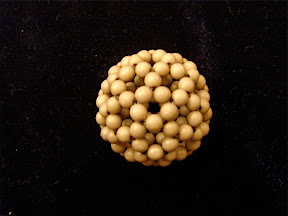 |
| From Craft Projects |
Another one I made is isomer 50:24 with spiral code 1 2 3 4 7 12 17 22 24 25 26 27, which is an isomer of C50. The shape of this isomer looks like a bean or cocoon.
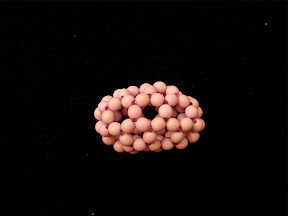 |
| From Craft Projects |
Minimum length of thread needed
The typical procedure to weave a beaded spheroid is to start from a 5- or 6-bead group, then use the right-angle weave technique to extend outward by adding more 5- or 6-bead groups aroud the central (first)-bead group in a spiral fashion. Whenever a 5-bead group is introduced, negative surface curvature is created, and thus the surface would be curved inward. According the Euler theory, to close a spheroid, 12 pentagons are needed. Thus along the path of spiral, we can put any number of hexagon we want, but a total number of 12 pentagons are needed to get a closed spheroid. Of course, if the sequence is arbitray, many of the structures are going to have very high energy. When a spheroidal fullerene can be contructed in this way, the thread will go through each each exactly twice, the amount of thread needed will simply s*2*N*d, where s is the scaling parameter to take the part of thread outside the beads into account.
According to the work by the British chemist, Fowler, there exist a class of fullerene system which can not be described by this way. An example is tetrahedral C380 as shown in his book entitled "An Atlas of Fullerenes". For this kind of system, we probably have to use longer lenth of thread because some beads will be stitched more than two times.
According to the work by the British chemist, Fowler, there exist a class of fullerene system which can not be described by this way. An example is tetrahedral C380 as shown in his book entitled "An Atlas of Fullerenes". For this kind of system, we probably have to use longer lenth of thread because some beads will be stitched more than two times.
Minimum length of thread needed to weave a fullerene
What is the minimum length of thread you need to build a stable beaded fullerene. By stable I mean the beaded fullerene should satisfy VSEPR principle everywhere. Probably not many people working on beadings worry about this kind of problem. I am not sure how hard the problem is in general. But the lower bound for the minimum length is quite easy. Since every bead has to be stitched at least twice to get a stable structure, therefore the minimum length must be greater than 2*N*d, where N is the number of beads and d the the diameter of bead. Better estimation can be found if the ratio of the size of hole and diameter of bead is taken into account. Furthermore, if the part of thread outside the beads is included, slight improvement can be obtained. This is just simple exercise in geometry, which can be worked in principle. We can also use empirical approach by performing a real experiment to find out the actual length used, then divide this number by the theoretical minimum 2*N*d, the scaling factor.
More complicated issue is that the lower bound with the scaled factor included is in general not the minimum length. It is possible to finish the beaded molecule, some beads may always be stitched through more than twice! This problem is not easy to explain. I will talk about this later.
More complicated issue is that the lower bound with the scaled factor included is in general not the minimum length. It is possible to finish the beaded molecule, some beads may always be stitched through more than twice! This problem is not easy to explain. I will talk about this later.
Tuesday, December 26, 2006
Force Field of Beaded Molecules
After a few days of thinking, I now realize that almost all of physical models commonly used for constructing the structure of molecules do not really use the microscopic force field of true molecules. The microscopic force field of a molecule is nothing but the repulsion between the electron pairs.The structure of physical model built from traditional balls and sticks does not obtain its structural stability from the repulsion between sticks. There is no interaction between these sticks in fact. As far as I can think of, our beaded molecule is probably the only physical model that really use the similar kind of pairwise hard-sphere repulsion to get the three-dimensional structure of the molecule. This is also the reason why the geometry of the beaded fullerene is in such a good agreement with that of the true molecule.
Right now, this approach only works for sp2-hybridized atoms. I guess it is possible to use beads to represent the repulsion interaction in the sp3-hybridized atoms, but it is probably not possible to generate the sp-type repulsion in the beaded network.
Right now, this approach only works for sp2-hybridized atoms. I guess it is possible to use beads to represent the repulsion interaction in the sp3-hybridized atoms, but it is probably not possible to generate the sp-type repulsion in the beaded network.
Saturday, December 23, 2006
On the Shape of Beaded Molecules
According to our experience, the major 3D structural features of the beaded molecules are very close to the optimized geometry obtained from more sophisticated force-field simulation. We find it is possible to give an explanation for this surprising result based on the VSEPR (Valence Shell Electron Pair Repulsion) theory as described in any General Chemistry textbook.
As I have commented before that beaded molecules are the bond-representation of the corresponding fullerene molecules. The beads are in fact C-C double bonds, instead of carbon atoms. This can be a little bit confusion to people who are familiar with the typical ball-and-stick model. When I shew these beaded molecules to my colleagues, many said that the structures are not correct. This is because at the first sight most people will view these beads as carbon atoms. However, they are not. Even though the bond-representation is a little inconvenient from traditional point of view, we believe that it is worthy to take the beaded-representation seriously since switching viewpoint is quite easy and, more importantly, the resulting giant beaded fullerenes are so aesthetically beautiful and faithful in its 3-D shape. We will show that the reason why the beaded molecules can have such a good structure is exactly due to this very bond-representation.
VSEPR theory accounts for the molecular shape for AXn by assuming that the repulsion between the electron pairs surrounding the central atom A causes these pairs to be oriented as far as possible. Hence in order to minimize the interaction between the two chemical bonds in the AX2, resulting shape becomes linear. When there are three chemical bonds around the central atom, the minimum structure will adopt a planar trigonal shape.
In the beaded molecules we constructed, there are only three kind of n-bead groups, i.e 5-, 6-, and 7-bead groups. Since two neighbored groups can only share one common bead, there are always three n-bead groups meet with each other by sharing one common bead with each other. Therefore these three common beads will form a close-pack triangle, representing exactly the three CC bonds around the central carbon atom. When the thread through these three beads is stretched outward strongly, the beads will be forced to stay as flat as possible just like situation described in the VSEPR.
Now we can understand why our beaded molecules can simulate the real toroidal compounds. It is exactly because the beads represent the chemical bonds instead of atoms, so that the repulsion among the beads in our beaded molecules can mimic the physical force that gives rise the structural features in the fullerenes. This is the reason why the 3D structures of our beaded molecules are so similar to those of the real molecules.
As I have commented before that beaded molecules are the bond-representation of the corresponding fullerene molecules. The beads are in fact C-C double bonds, instead of carbon atoms. This can be a little bit confusion to people who are familiar with the typical ball-and-stick model. When I shew these beaded molecules to my colleagues, many said that the structures are not correct. This is because at the first sight most people will view these beads as carbon atoms. However, they are not. Even though the bond-representation is a little inconvenient from traditional point of view, we believe that it is worthy to take the beaded-representation seriously since switching viewpoint is quite easy and, more importantly, the resulting giant beaded fullerenes are so aesthetically beautiful and faithful in its 3-D shape. We will show that the reason why the beaded molecules can have such a good structure is exactly due to this very bond-representation.
VSEPR theory accounts for the molecular shape for AXn by assuming that the repulsion between the electron pairs surrounding the central atom A causes these pairs to be oriented as far as possible. Hence in order to minimize the interaction between the two chemical bonds in the AX2, resulting shape becomes linear. When there are three chemical bonds around the central atom, the minimum structure will adopt a planar trigonal shape.
In the beaded molecules we constructed, there are only three kind of n-bead groups, i.e 5-, 6-, and 7-bead groups. Since two neighbored groups can only share one common bead, there are always three n-bead groups meet with each other by sharing one common bead with each other. Therefore these three common beads will form a close-pack triangle, representing exactly the three CC bonds around the central carbon atom. When the thread through these three beads is stretched outward strongly, the beads will be forced to stay as flat as possible just like situation described in the VSEPR.
Now we can understand why our beaded molecules can simulate the real toroidal compounds. It is exactly because the beads represent the chemical bonds instead of atoms, so that the repulsion among the beads in our beaded molecules can mimic the physical force that gives rise the structural features in the fullerenes. This is the reason why the 3D structures of our beaded molecules are so similar to those of the real molecules.
Thursday, November 30, 2006
Subscribe to:
Posts (Atom)

